LOCTITE CRANK FIX - PART
2
The procedure is very
similar to a timing belt change, except that you re-use the old belt. Follow the
same
steps you would need to
disassemble the front of the motor and expose the crank shaft. Here are
some
photos to show the scope of the project.
DISCLAIMER
See a Mazda Shop Manual for comprehensive instructions on
timing belt replacement. This page is for information only and does not
represent instructions or procedures.
Some Photo Highlights
 |
 |
|
Getting ready to open timing covers. Radiator is drained. Intake
plumbing and coolant hoses removed. Accessory belts off. It's far easier
to work with the plastic pan under the motor removed.
I also removed the fans and dropped the sway bar. |
Valve cover is off. Timing covers off. I rotated the crankshaft to top
dead center and marked the belt with white paint (white-out) so I could
easily put it back the same way.
As I did not replace the belt, I left the little coolant hoses in place
and just swung the belt out of the way. |
|
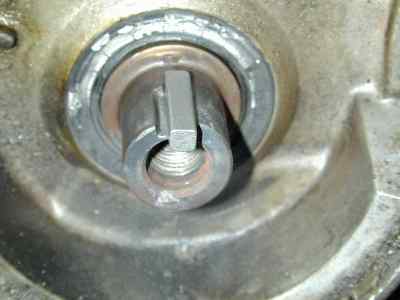 |
New woodruff key on worn crank. The keyway wear allowed the pulley to
slip about 10 degrees which would be a 20 degree retard on the valve
timing. The old key was worn and allowed the slippage. With a new key,
there was enough contact to align the gear and crankshaft for re-assembly.
The fixture described below would still allow alignment and assembly of
the crank pulley. |
|
I did have one major problem doing this fix. Even though
the old crank bolt was finger tight when I first tried to remove it, a little
bit of rust and a burr on the threads caused it to seize. Instead of getting out
the Liquid Wrench and trying to rock it out, I forced it and it snapped
off. I later removed what was left of the bolt with a screw extractor, propane
torch, 8 hours of effort, and a lot of thinking. Be careful!
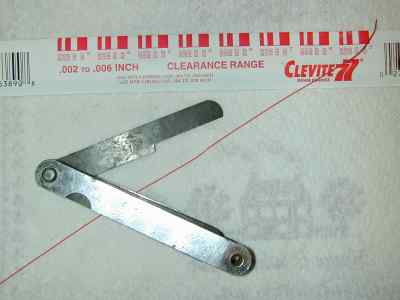 |
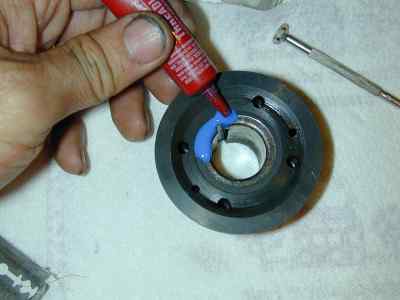 |
|
Clearance between pulley and crank should be checked to see if it
exceeds .020 mm. This is usually done using plastigage. It's a plastic
string inserted between the pulley and crank and then squashed as the two
parts mate. The width of the squashed part is checked against a chart for
the clearance. I couldn't fit the plastigage between the two surfaces
without it being cut.
I finally snipped off a small piece of .020 shim from an old feeler
gauge and used that as a go/no-go check. My tolerances were under the .020
number. If it had been over, then Loctite 660 is recommended between the
crankshaft and pulley surface. |
I put Loctite on the crankbolt and anywhere there was
metal-to-metal contact on the gear, even on the back as shown above. It
also went on the inner surface of the gear.. In the keyway slot, I used
Loctite 660. As mentioned on the left, the 660 product is only used in the
keyway unless the pulley-crankshaft clearance exceeds .020 mm.
|
|
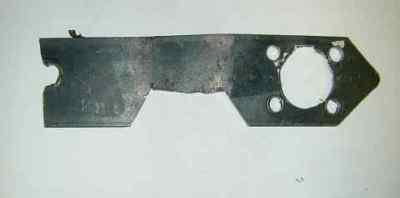
This crude
tool took about two hours to make. It maintains crank/pulley
allignment while torquing the bolt. Without it, it's my opinion there is
some risk that the pulley will slip out of alignment because of the wider
keyway when the bolt is tightened.
It also locks the crank and allows easier application of torque. I
highly recommend its use. |
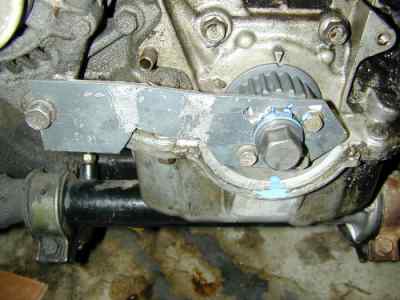
Here is the pulley locked down with the home made fixture. Note that
because I was sloppy in making it, only three of the four hold-down bolts
fit the fixture,
The bolt has been tightened to 85 foot pounds with an accurate torque
wrench. Excess loctite is dripping off the assembly.
The loctite 242 that I used has a long setup time, but the loctite 660
will start to set within minutes after assembly. I worked quickly. It took
less than 15 minutes to mount the pulley, bolt on the fixture, spin on the
crank bolt and torque the assembly.
It's very important to allow 24 hours for curing. Since I was in no
rush, I gave it 48 hours before I did any further work on the
engine. |
RESULTS
Reassembly was straight forward. The engine started after I
put it back together. Re-alignment of the crank pulley gave me the correct valve
timing again. This really improved the performance of my car. For performance, I
use a benchmark for the 50-70 mph time in 5th gear on a level, clear road. I
find it a reproducible test. Prior to the crank fix, I was seeing 14-16 seconds.
After the work, this dropped to around 11-12 seconds, which is fairly typical
for a 1990 1.6 liter miata. Most cars will run this test between 11 and 13
seconds.
Now, we're in the life testing phase on this fix. I
originally did this on Election Day in November, 2000. As I update this page, I
now have been driven my miata for 20 months and about 11000 miles. It seems to
be running fine and I can still hit the above performance benchmark which says
the crank pulley hasn't slipped. For me, it's been an effective low cost
repairs. In any case, I've managed to forestall an engine swap for almost two
years.
I've also heard from other owners who have done the same
procedure with similar results. However, I've seen one post on the miata forum,
from an owner who said this procedure didn't work for his turbocharged car. As
always, your results may vary.
Harry Sue
Updated July 12, 2002








